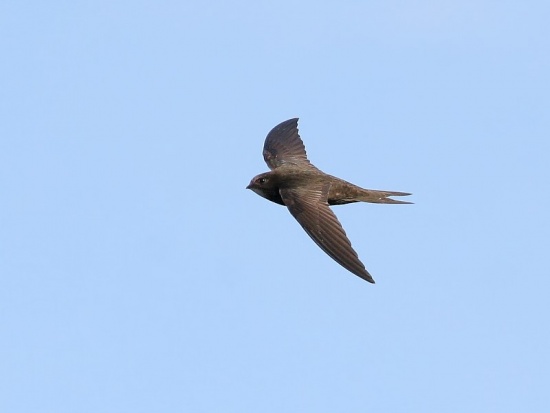| Line 4: | Line 4: | ||
==Identification== | ==Identification== | ||
| − | Common Swifts are 16-17 cm long and entirely blackish-brown except for a small white or pale grey patch on their chins which is not visible from a distance. They have a short forked tail and very long swept-back wings that resemble a crescent or a boomerang. | + | Common Swifts are 16-17 cm long and entirely blackish-brown except for a small white or pale grey patch on their chins which is not visible from a distance. They have a short forked tail and very long swept-back wings that resemble a crescent or a boomerang.<br /> |
| + | The inner par of the wing has front and back edge paralel to each other. Swallows and Martins have wings giving a more triangular impression. | ||
| + | |||
==Distribution== | ==Distribution== | ||
By far the commonest swift of much of its range. Breeds from the Mediterranean north to northern [[Scotland]], central [[Norway]] and the Kola Peninsula. Breeds across North-West [[Africa]] and in scattered localities in the [[Middle East]]. Has bred on [[Malta]] and recently discovered breeding in the [[Canary Islands]]. To the east range extends across [[Asia]] to northern [[China]]. | By far the commonest swift of much of its range. Breeds from the Mediterranean north to northern [[Scotland]], central [[Norway]] and the Kola Peninsula. Breeds across North-West [[Africa]] and in scattered localities in the [[Middle East]]. Has bred on [[Malta]] and recently discovered breeding in the [[Canary Islands]]. To the east range extends across [[Asia]] to northern [[China]]. | ||
Revision as of 01:45, 1 June 2009
- Apus apus
Identification
Common Swifts are 16-17 cm long and entirely blackish-brown except for a small white or pale grey patch on their chins which is not visible from a distance. They have a short forked tail and very long swept-back wings that resemble a crescent or a boomerang.
The inner par of the wing has front and back edge paralel to each other. Swallows and Martins have wings giving a more triangular impression.
Distribution
By far the commonest swift of much of its range. Breeds from the Mediterranean north to northern Scotland, central Norway and the Kola Peninsula. Breeds across North-West Africa and in scattered localities in the Middle East. Has bred on Malta and recently discovered breeding in the Canary Islands. To the east range extends across Asia to northern China.
A summer visitor throughout range , wintering in sub-Saharan Africa and India. Autumn passage is mainly late July-September, rarely until late October, even November. Return movement reaches southern Europe in late March, further north in late April-May.
Taxonomy
Nominate race breeds over much of the Western Palearctic with pekinensis occurring on passage through the Middle East and breeding in Asia, paler and browner plumage with more extensive white throat patch.
Habitat
Feeds chiefly over open country and often over water, commonly in urban areas, in lowlands or mountains. Breeds mainly in holes in buildings, but also crevices in cliffs and caves.
Behaviour
Swifts spend most of their lives in the air, living on the insects they catch in their beaks. They drink and even sleep on the wing.
Vocalisation
<flashmp3>Apus apus (song).mp3</flashmp3>
Listen in an external program




